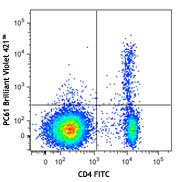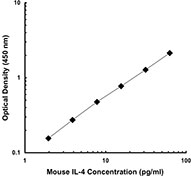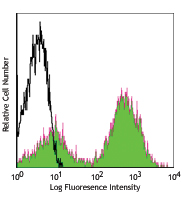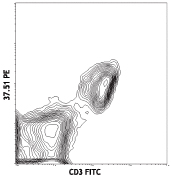- Clone
- R4-6A2 (See other available formats)
- Regulatory Status
- RUO
- Other Names
- Interferon-γ, Immune interferon, Type II interferon, T cell interferon, Macrophage-activating factor (MAF), IFN-g, IFN-gamma
- Isotype
- Rat IgG1, κ
- Ave. Rating
- Submit a Review
- Product Citations
- publications
| Cat # | Size | Price | Quantity Check Availability | Save | ||
|---|---|---|---|---|---|---|
The equivalent Ultra-LEAF™ product may be available at comparable or significantly lower price.Didn't find what you were looking for? Try using our Advanced Search to find products.Would you like to recommend a new product? Contact our business development team.Would you like a custom conjugated antibody product? Contact our custom solutions team.
Interferon-γ is a potent multifunctional cytokine which is secreted primarily by activated NK cells and T cells. Originally characterized based on anti-viral activities, IFN-γ also exerts anti-proliferative, immunoregulatory, and proinflammatory activities. IFN-γ can upregulate MHC class I and II antigen expression by antigen-presenting cells.
Product DetailsProduct Details
- Verified Reactivity
- Mouse
- Antibody Type
- Monoclonal
- Host Species
- Rat
- Immunogen
- Partially-purified, native mouse IFN-γ
- Formulation
- 0.2 µm filtered in phosphate-buffered solution, pH 7.2, containing no preservative. Endotoxin level is <0.1 EU/µg of the protein (<0.01 ng/µg of the protein) as determined by the LAL test.
- Preparation
- The LEAF™ (Low Endotoxin, Azide-Free) antibody was purified by affinity chromatography.
- Concentration
- 1.0 mg/ml
- Storage & Handling
- The antibody solution should be stored undiluted between 2°C and 8°C. This LEAF™ solution contains no preservative; handle under aseptic conditions.
- Application
-
ELISA Capture - Quality tested
ELISPOT Capture, Neut, IHC - Reported in the literature, not verified in house - Recommended Usage
-
Each lot of this antibody is quality control tested by ELISA assay. For ELISA capture applications, a concentration range of 0.5-2.0 µg/ml is recommended. To obtain a linear standard curve, serial dilutions of IFN-γ recombinant protein ranging from 2000 to 15 pg/ml are recommended for each ELISA plate. It is recommended that the reagent be titrated for optimal performance for each application.
- Application Notes
-
ELISA Capture1-4,6,10,11 or ELISPOT Capture5: The purified R4-6A2 antibody is useful as the capture antibody in a sandwich ELISA or ELISPOT assay, when used in conjunction with the biotinylated XMG1.2 antibody (Cat. No. 505804) as the detecting antibody and recombinant mouse IFN-? (Cat. No. 575309) as the standard. The Ultra-LEAF™ purified antibody is suggested for ELISPOT capture. For ELISPOT Capture, the suggested use of this antibody is 1.0 - 4.0 µg/mL.
ELISA or ELISPOT Detection: The biotinylated R4-6A2 antibody is useful as the detecting antibody in a sandwich ELISA or ELISPOT assay, when used in conjunction with the purified XMG1.2 antibody (Cat. Nos. 505802 & 505812) as the capture antibody and recombinant mouse IFN-? (Cat. No. 575309) as the standard.
Neutralization1,2,9: The Ultra-LEAF™ purified antibody (Endotoxin <0.01 EU/µg, Azide-Free, 0.2 µm filtered) is recommended for neutralization of mouse IFN-? bioactivity in vivo and in vitro (Cat. Nos. 505708 - 505713).
Additional reported applications (for the relevant formats) include: immunohistochemical staining3,6,8 of acetone-fixed frozen tissue sections.
Note: For testing mouse IFN-? in serum, plasma or supernatant, BioLegend's ELISA Max™ Sets (Cat. No. 430801 and 430804) are specially developed and recommended. -
Application References
(PubMed link indicates BioLegend citation) -
- Abrams J, et al. 1992. Immunol. Rev. 127:5.
- Stevenson M, et al. 1990. Infect. Immun. 58:3225.
- Sander B, et al. 1993. J. Immunol. Meth. 166:201.
- Yang X, et al. 1993. J. Immunoassay 14:129.
- Klinman D, et al. 1994. Curr. Prot. Immunol.. John Wiley and Sons, New York. Unit 6.19.
- Sander B, et al. 1991. Immunol. Rev. 119:65.
- Finkelman F, et al. 2003. Curr. Prot. Immunol. John Wiley & Sons, New York. Unit 6.28.
- Khanna A, et al. 2000. J. Immunol. 164:1346.
- Terrazas LI, et al. 2005. Intl. J. Parasitology. 35:1349.
- Dzhagalov I, et al. 2007. J. Immunol. 178:2113.
- Xu G, et al. 2007. J. Immunol. 179:5358.
- Product Citations
-
Antigen Details
- Structure
- Cytokine; dimer; 40-80 kD (Mammalian)
- Bioactivity
- Antiviral/antiparasitic activities; inhibits proliferation; enhances MHC class I and II expression on APC
- Cell Sources
- CD8+ and CD4+ T cells, NK cells
- Cell Targets
- T cells, B cells, macrophages, NK cells, endothelial cells, fibroblasts
- Receptors
- IFN-γRα (CDw119) dimerized with IFN-γRβ (AF-1)
- Cell Type
- Tregs
- Biology Area
- Cell Biology, Immunology, Neuroinflammation, Neuroscience
- Molecular Family
- Cytokines/Chemokines
- Antigen References
-
- Fitzgerald K, et al. Eds. 2001. The Cytokine FactsBook. Academic Press, San Diego.
- De Maeyer E, et al. 1992. Curr. Opin. Immunol. 4:321.
- Farrar M, et al. 1993. Annu. Rev. Immunol. 11:571.
- Gray P, et al. 1987. Lymphokines 13:151.
- Regulation
- Upregulated by IL-2, FGF-basic, EGF; downregulated by 1-α-25-Dihydroxy vitamin D3, dexamethasone
- Gene ID
- 15978 View all products for this Gene ID
- Specificity (DOES NOT SHOW ON TDS):
- IFN-gamma
- Specificity Alt (DOES NOT SHOW ON TDS):
- IFN-γ
- App Abbreviation (DOES NOT SHOW ON TDS):
- ELISA Capture, ELISPOT Capture, IHC, Neut
- UniProt
- View information about IFN-gamma on UniProt.org
Related FAQs
- Do you guarantee that your antibodies are totally pathogen free?
-
BioLegend does not test for pathogens in-house aside from the GoInVivo™ product line. However, upon request, this can be tested on a custom basis with an outside, independent laboratory.
- Does BioLegend test each Ultra-LEAF™ antibody by functional assay?
-
No, BioLegend does not test Ultra-LEAF™ antibodies by functional assays unless otherwise indicated. Due to the possible complexities and variations of uses of biofunctional antibodies in different assays and because of the large product portfolio, BioLegend does not currently perform functional assays as a routine QC for the antibodies. However, we do provide references in which the antibodies were used for functional assays and we do perform QC to verify the specificity and quality of the antibody based on our strict specification criteria.
- Does BioLegend test each Ultra-LEAF™ antibody for potential pathogens?
-
No, BioLegend does not test for pathogens in-house unless otherwise indicated. However, we can recommend an outside vendor to perform this testing as needed.
- Have you tested this Ultra-LEAF™ antibody for in vivo or in vitro applications?
-
We don't test our antibodies for in vivo or in vitro applications unless otherwise indicated. Depending on the product, the TDS may describe literature supporting usage of a particular product for bioassay. It may be best to further consult the literature to find clone specific information.
Other Formats
View All IFN-γ Reagents Request Custom Conjugation| Description | Clone | Applications |
|---|---|---|
| Biotin anti-mouse IFN-γ | R4-6A2 | ELISA Detection,ELISPOT Detection |
| Purified anti-mouse IFN-γ | R4-6A2 | ELISA Capture,IHC |
| Ultra-LEAF™ Purified anti-mouse IFN-γ | R4-6A2 | ELISA Capture,ELISPOT Capture,IHC-F,Neut |
Customers Also Purchased
Compare Data Across All Formats
This data display is provided for general comparisons between formats.
Your actual data may vary due to variations in samples, target cells, instruments and their settings, staining conditions, and other factors.
If you need assistance with selecting the best format contact our expert technical support team.
 Login/Register
Login/Register 

















Follow Us